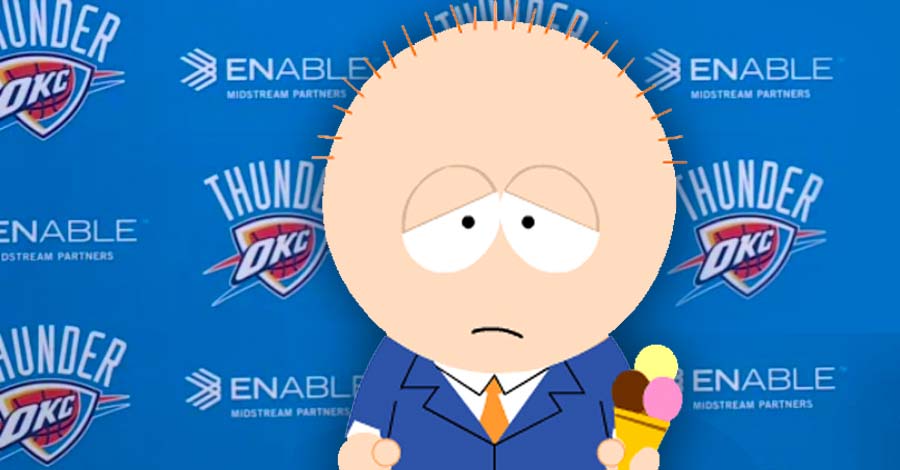With two weeks until training camp is set to start, the Thunder roster is likely set. Following a season that was difficult to watch, both literally and figuratively, fans may have hoped to see wholesale changes. Alas, the guys heading in to training camp are essentially the same guys who executed the 22-50 record of 2020-21.
Of the players that were on the team for the season finale against the Clippers, only Moses Brown, Tony Bradley, Jaylen Hoard, Svi Mykhailiuk and Al Horford have moved on. They have been replaced by five draft picks (Josh Giddey, Tre Mann, Aaron Wiggins, Jeremiah Robinson-Earl, Vit Krejci) and a trade acquisition that came with a draft pick (Derrick Favors). One could, and probably should, argue that this roster is actually worse.
That said, the goal today is to analyze the roster and rank the players by their value to the franchise. To do that, I devised a system of rating each player from 1 to 10 in ten categories. Those categories are:
Name Recognition: A score of ten would mean that the player is so well known that even soccer fans are aware of him. A one would suggest his mother might be able to place him if given two guesses.
Potential: How much capability the player has to improve. A perfect score would be a player with superstar capability that has a long way to reach that status. A low score would mean that the player is well past their prime or is unlikely to improve.
Scoring: How much of a threat is this player to score? A player rated ten would be a player teams game plan to contain because stopping them is hopeless. A player rated one would be a guy who defenses ignore and still only gets on the scoreboard by accident.
Shooting: Shooting is different from scoring. A scorer may be able to shoot, but a shooter doesn’t necessarily need to score to impact a game. Someone rated a ten cannot be sagged away from regardless of where they are on the floor because when they put the ball up, fans are shocked if it doesn’t go in. Meanwhile, a one rated shooter is, well, Andre Roberson.
Passing: This is about willingness to pass as much as quality of passes. A ten player makes good reads and values ball movement. A one player is a black hole that generally shoots whenever they touch the ball.
Rebounding: A ten rebounder would be a guy who grabs every loose ball. A one rebounder would be a guy who has no interest in getting around all those sweaty dudes going for the ball.
Defense: Someone rated a 10 in defense changes the game with their defensive prowess, while the one rating would belong to a guy who every coach tries to isolate in pick-and-rolls.
Athleticism: 10 = Carl Lewis at the 1984 Olympics; 1 = Gheorge Muresan for the Washington Bullets
Trade Value: If no offer could get Sam Presti to consider offloading this player, he’s a ten. If Presti couldn’t get rid of him even if he offers some draft picks, that’s a one.
Contract: When a player’s contribution provides far more value to the team than what it costs the Thunder to pay him, that’s a ten. A player that is so overpaid that Sam Presti would only be able to get off his contract by contacting another Sam Presti in a different dimension, that’s a one.
To get these ratings, I assembled a crack team of evaluators. They were:
Clark Matthews: The long-winded basketball obsessed Editor Emeritus of The Lost Ogle and author of this article.
Patrick Riley: A five-time NBA champion as head coach of the Los Angeles Lakers, and……Oops, no. He’s the publisher of a website called The Lost Ogle and brings a more casual fan approach to the ratings.
Jacob Kniffen: Host of The Uncontested podcast on the Bluewire Podcast network, and a guy whose Eurostep has been blown up by Clark Matthews nearly as many times as he’s wrecked Clark Matthews with his Eurostep.
Now, for the player rankings (average total score in parenthesis):
Roster Excess
18. Charlie Brown, Jr. (20)
17. Gabriel Deck (26)
These two are the roster fodder of the team. At minimum, the team has to cut one player before opening night, and whoever is cut to make room is bound to be among these two. Perhaps both. There were reports from Spain that Deck had decided to return to the Spanish ACB, but then the date for Deck’s contract to become partially guaranteed passed without him being waved. That seems like really bad news for Brown whose contract contains no guarantees if he fails to make the opening night roster.
Two-Way Players
16. Josh Hall (26)*
15. Aaron Wiggins (38)
It isn’t strange that the players who have “two-way contracts” are this low on the list. The surprising part is that they rank ahead of two players that were signed to ordinary NBA contracts. They actually snuck ahead because they were rated slightly higher in potential and contract (their salaries are really low).
* -- Hall was waived in between the compilation of these rankings and the publication of this article
Bench Warmers
14. Vit Krejci (38)
13. Derrick Favors (41)
12. Isaiah Roby (41)
11. Mike Muscala (42)
10. Ty Jerome (42)
This tier contains two veterans and three borderline prospects. Of this group, Krejci (a 6’8” point guard drafted in the second round of the 2020 draft) was rated as the player with the highest potential, slightly ahead of Jerome. Meanwhile, Jerome and Muscala were tied for the second-best shooter on the team, but both had their scores hampered by a lack of athleticism.
While this tier has been labeled as “the bench warmers,” Favors is probably in line to start at center. He ranked near the top in defense and rebounding, but his contract and lack of potential dropped his value to the team significantly.
Rotation Players
9. Jeremiah Robinson-Earl (45)
8. Tre Mann (45)
7. Darius Bazley (47)
6. Theo Maledon (48)
This is the tier of players that Thunder fans hope can develop into a long-term rotation player. The biggest surprise in this grouping is Bazley, the longest tenured player on the team, who just turned 21 years old. After showing glimpses that could be portrayed as greatness his rookie season, he certainly underwhelmed when given a bigger role in his second year. What really dragged him down in this exercise was his atrocious, though high volume, shooting. He had the lowest rating of anyone in the top-15.
Starter Caliber
5. Kenrich Williams (49)
“Kenny Hustle” was a massive surprise. Only signed to a contract so that the Pelicans could have enough salary to make the Steven Adams trade work, Williams proved to be a valuable “energy guy” for the Thunder. Our panel ranked him in the top-5, primarily on the strength of outplaying his contract and being a pest on defense.
4. Josh Giddey (56)
Being ranked number four despite playing only five minutes of Summer League ball suggests that there are some high expectations for the Thunder’s top pick in the 2021 draft. Our panel gave him high marks on passing (all three rated it a nine), potential (tied for second on the team), and trade value.
3. Aleksej Pokucevski (59)
By some statistical metrics, Poku was the worst player in the NBA last season. By the eye test, though, he may be the most confident player in the league. Those two things are related. As the youngest player on any team, Poku still received a ton of minutes. He played everywhere from point guard to center. He fired shots up at will and made fascinating behind the back passes that were awesome if they were received by one of his teammates. (To be honest, some of the turnovers he made that way were still awesome since they added flavor to the losses.) Coach Daignault was clearly giving him freedom to work on his game.
Eventually, we as fans hope, that confidence will convert into a more polished product that helps the team wins games. For that reason, his potential score was close to perfect. Being on a rookie scale contract also pushed him up the rankings.
2. Lu Dort (63)
I will never understand how Sam Presti convinced Lu Dort to sign a four-year contract that paid just above league minimum. As an undrafted free agent after the 2019 draft, the Thunder signed Dort on a “two-way contract” that was supposed to make him mostly a G-League player. But because of his instant success as a defensive stalwart, he was immediately starting alongside Chris Paul and shutting down every team’s best perimeter scorer. His two-way contract expired right before the playoffs and Dort could (should?) have held the team hostage for a big pay day.
That contract is now the most team friendly thing in the NBA, especially after Dort blossomed into a scary scoring threat in year two. Still only 22 years-old, our panel felt that he still has a lot of potential to improve. He also rated as the team’s best athlete and second highest trade value.
1. Shai Gilgeous-Alexander (70)
It would have been surprising if anyone else had landed the top spot. He leads the team in name recognition, scoring, shooting, and trade value while coming in second in passing, rebounding and—surprisingly considering how far he’s already come in his first three seasons—potential. The only number that pulled him down was contract, and only then because it’s very difficult to outplay a max deal.
__
So those are the rankings. Go ahead and argue about them in the comment section.







